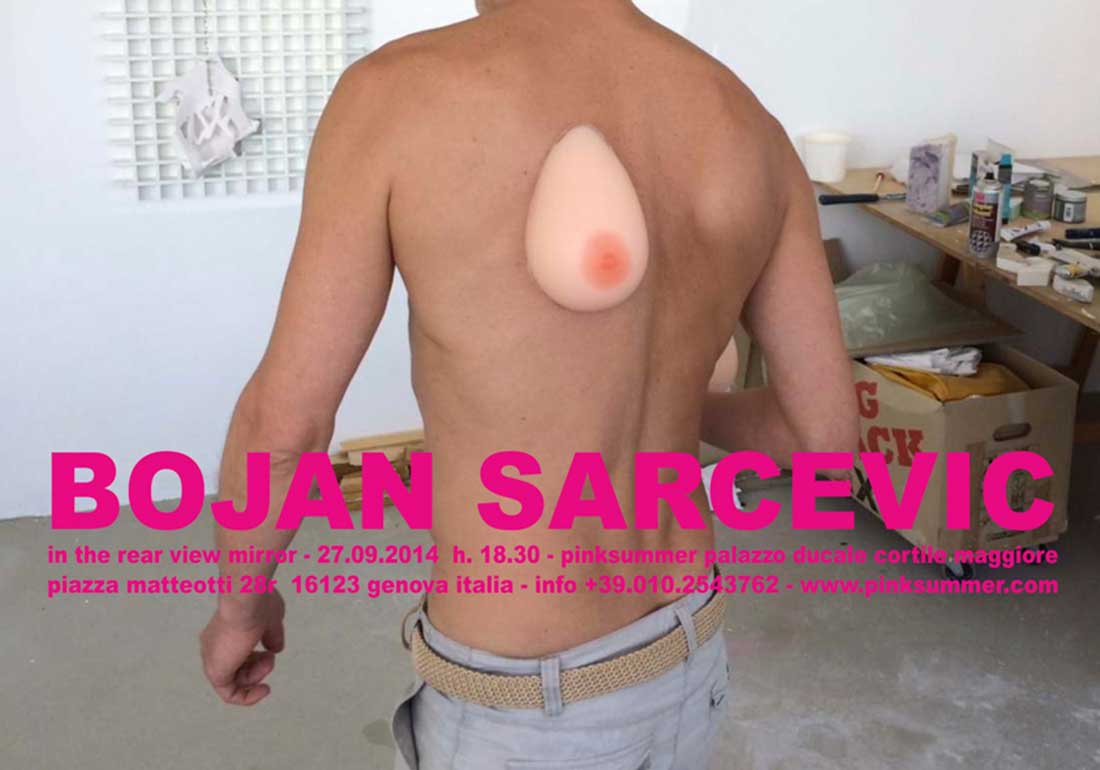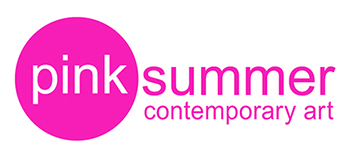Bojan Sarcevic – In the rear view mirror

Press-release
We could tell that what we know of Bojan Šarcevic’s solo show at pinksummer are just a few ingredients, not the entire recipe. We have got its title, “In the rear view mirror”, the image for the invitation card and other photos; 31 items shipped by the artist are in the gallery and some works in progress are going to transform the venue. We know that Šarcevic has been working hard at the exhibition and he is still working in his rigorous mode, but refusing any a priori deterministic model.
Bojan Šarcevic has been sharing with us the process informing his show step by step, but he did that without using any verbal prosthesis apart from what strictly necessary for the actualization of his project on site, aiming, we guess, to make the venue more specific to itself as a contemporary art gallery per se, rather than to adapt it to some specific artworks to be held. By performing light but significant modifications to the gallery space, somehow Šarcevic retouched our professional identity and, on purpose or not, stimulated a reflection on what we would have wished, or had, to be. As a matter of fact, Šarcevic has created inside the frame of our everyday working environment, a new one, smoother, polished and fluffy, where we may move, at least temporary, in a more appropriate and reliable way.
In his book “Inside the White Cube . The Ideology of the Gallery Space” Brian O’Doherty wrote: “the gallery is the locus of power struggles conducted through farce, comedy, irony, transcendence, and of course, commerce.”
Separately displayed, there will a scale model for “rifugio”(mountain hut) too, fine and elegant as Šarcevic sculpture can be, essential like any architecture conceived for a sober living, free from any distraction. The idea is to let the artist build the “rifugio” in an enjoyable place in the middle of the nature. As if that mountain hut acted like the vanishing point in perspective.
Speaking about disguising, one of the first images sent by Šarcevic for “In the rear view mirror” features a European man in his late thirties sitting in front of the camera with an extraeuropean wooden mask on his chest. The mask represents a feminine breast, sagging because of breast-feeding, a universal symbol of fertility definitely little appealing according to contemporary western canon of female beauty. The hippie shirt of the virile and bearded man dates back the image to the 60ies or 70ies of last century. Within the various extra European cultures in which these feminine masks were/are ritually used to banish the demons (Tanzania, Mozambique) they had/have rigorously to be worn by men.
Later, Šarcevic sent us the image to us for the invitation card of the exhibition: a man with his back turned, whose head makes as if to turn to the right and on whose left bachelor emerges one round and rose-colored feminine breast, like a fantastic and inconceivable wing. Even though free from any excess and exaggeration, the image on the invitation card recall the idea of grotesque body outlined by Michail Bachtin, a transforming body, interested to all that spring from the body, to any excrescence that tries to escape to the qualitative and quantitative borders of the individual body .
It is a kind of body that tends to overcome the separation with the other, no matter if that is another body or the space around. According to Bachtin, the grotesque body is a body that swallows the world and let the world swallow it. The grotesque transformation addresses always the border between two bodies, the point of intersection connecting the body with the environment, therefore tends to dualism and bicorporeity.
The feminine of the silicone breast of “In the rear view mirror” refers to a purely expressive and characterological organ, as independent as it was a self-existing body.
Looking back to his previous works, the relationship with the feminine element has been openly present in Šarcevic’s work of last years. We are thinking at the exhibition “Involuntary twitch” curated by Lorenzo Benedetti, co-produced with pinksummer and presented for the first time in 2010 at De Vleeshal in Middelburg, Holland, and namely the series of works “Presence at night”, in which the feminine assumes fantastic and uncanny nocturnal connotations, that might remind of Lilith or Lorelei, whose long hairs entangle in the dreams of a man until obsessing him; also, in a more hidden and indirect way, we are referring to the ineffable watercolor fluids of “Stamina and the Muse”.
Again in 2010, the solo show “Comme des chiens et des vagues” held at Stuart Shave/Modern Art in London presented for the first time the monumental sculpture “She”, since than usually paired in public venues with “He”, both made from a massive block of onyx (“Elipse of an Elipse”, IAC Institut of art contemporain Villeubanne/Rhône-Alpes 2012 and “A curious contortion in the method of progress”, Kunstmuseum Liechtenstein, always 2012). “She” appears like some sort of Eve, who inverts the creation myth by preceding “He” (Art Unlimited, Art Basel 42, Stuart Shave Modern Art, 2011). In London exhibition, Šarcevic also presented a series of small metal sculptures laid on the gallery floor.
The same sculptures appeared in the photographs on the walls in an unexpected setting, as if they were tools with a mysterious function, related to the semi naked bodies of some young female models.
About the title of pinksummer exhibition, “In the rear view mirror”, recently it was published in Italy an essay by Salvatore Silvano Nigro titled ” The door-keeper of the devil: glasses and other concerns”, which focuses on the intelligence of glasses that, by approaching the distance and shortening the intervals, tend to disembody the eye and let the glance raise to extra dimensions, at least that of imagination. That book tells about the microscope, the telescope, that was taken to China by Jesuits and called “the glass of a thousand li”, about incense burners, burning glasses and mirrors.
The exhibition “In the Rear View Mirror” recalls a particular type of mirror, Pearl Jam in the song “Rearviewmirror” asserts that things seen in the rear-view mirror are much clearer and all what we left behind appears more present and closer. The rear-view mirror is an extension and an strengthening of a retrospective look. There is also a book by Dave Goldberg titled “The Universe in the Rearview Mirror: How hidden Symmetries Shape Reality”. And, let’s say it frankly, a retrospective device makes a bit less absurd to look at a shining star and think that its light was extinguished millions of year before being touched by our gaze.
Moreover, about excrescence, ramification and fantastic buds able to cancel limits and borders between one body and another one, a body and the space and the space and the time, the rear-view mirror, we found it out thanks to Bojan Šarcevic show, was invented in 1911 by a pilot who mounted that device on the hood of his car to get rid of the weight of the mechanic on board, that the other pilots, still excluded from the asymmetry that implies the jump of evolution, had to accommodate on their cars to be informed about the traffic behind their shoulders.
Stretching, indeed too far, hidden symmetries and ring theory, in the same year 1911 Picasso pasted on the surface of a painting a piece of oil cloth reproducing the chair caning, a work that Brian O’Doherty defined in his aforementioned essay “(…)collage’s Exhibit A” and claiming “(…) Analytic Cubism didn’t push laterally but poked out the picture plane”.
One could consider new Bojan Šarcevic exhibition “In the rear view mirror” as something similar to his first solo show at pinksummer in 2002, a dis-homogeneous exhibition, hidden, consistently in progress like a journal: something about the possible meanings that everyday experience may assume afterwards on the track of some undisclosed diary.
However, we can suggest to look at “In the rear view mirror” as if it was a very very jutting collage.


